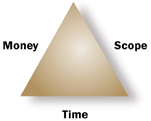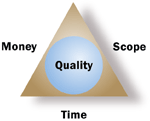Every Project plan is a triangle
It doesn't matter what industry you're in, how experienced you are, how "different" your project is, or what version of project management methodology your organization uses. At every project's core is the trio of time, money, and scope. These are the factors you juggle every day to keep your Project plan on track.
In this article
What is the project triangle?
If time, money, or what your project accomplished were unlimited, you wouldn't need to do project management. Unfortunately, most projects have a specific time limit, budget, and scope.
It is this combination of elements (time, money, and scope) that we refer to as the project triangle. (These competing elements are sometimes referred to as the triple constraints of a project.) Understanding the project triangle will allow you to make better choices when you need to make tradeoffs.

If you adjust any one side of the triangle, the other two sides are affected.
For example, if you decide to adjust the project plan to:
-
Bring in the scheduled finish date, you might end up with increased costs and a decreased scope.
-
Meet the project budget, the result might be a longer schedule and a decreased scope.
-
Increase scope, your project might take more time and cost more money in the form of resources, such as workers.
Changes to your plan can affect the triangle in various ways, depending on your specific circumstances and the nature of your project. For example, in some instances, shortening your schedule might increase costs. In other instances, it might actually decrease costs.
In terms of the project triangle, resources are considered a cost item. So as you adjust resources to accommodate more or less work or to reflect their availability, your costs go up or down correspondingly. These costs are based on resource pay rates.
You also may notice that as you adjust resources, your schedule changes. For example, if you have a number of resource overallocations and you level the project, the schedule might now include split tasks and delays that extend the finish date.
Learn more:
-
Explore schedule optimization using using the The Project Road Map.
-
Download and print out the "Project management quick reference guide for Project 2007" by searching for it as a template in Word.
Where's the stuck side of the triangle?
Did you say "stuck side"? That's right. In most projects, at least one side of the triangle is stuck, meaning you're stuck, because you can't change it. On some projects, it's the budget. No matter what, you won't get more money for the project. On others, it's the schedule—the dates can't change. Or it's the scope—there will be no change in deliverables.
The trick is in finding the the "stuck" or fixed sides of your project's triangle. That tells you what you can change and where to adjust if there's a problem. Phrasing the problem as a statement can help you clarify which side of the triangle is in trouble.
Knowing which side of your triangle can't be changed will help you know where to adjust. So when you begin optimizing:
-
First, decide which of the three elements is fixed. This is typically the element most important to the success of your project (finishing on time, on budget, or with the agreed-upon scope).
-
Then, determine which side your current problem occurs on. Once you've done that, you'll know what elements you have to work with to get your project back on track.
If the problem side and the fixed side are the same, you have the remaining two sides of the triangle to work with. For example, if your project has to finish on time and your problem is that it's taking too long, you can adjust resources or adjust scope to get the project back on track.
If the problem side is different than the fixed side, you'll want to optimize by adjusting the remaining side. For example, if your project has to finish on time and it's grown in scope, you only have the cost side to play with by, for instance, by adding resources.
Know that when you adjust one side of the triangle of time, money, and scope, the other two sides are likely to be affected. They can be affected positively or negatively, depending on the nature of your project.
Note: After adjusting your project plan, check the other two elements again to make sure nothing has become unworkable. For example, if you adjusted your plan to bring in costs, check to see if your finish date is still acceptable.
How do I optimize to meet my schedule?
After analyzing your schedule, you might find it does not meet the project deadline. There are several ways you can adjust the length of your schedule. The methods you choose depend on the limitations imposed on the project as a whole, such as budget, resource availability, scope, and the flexibility of the tasks.
The most efficient way to shorten the schedule is to change the tasks that lie on the critical path. The critical path is a series of dependent tasks whose last task finishes at the project end date. If any of the tasks in this series move, the project end date also moves. Modifying tasks that are not on the critical path may not affect the schedule. You can:
-
Shorten the durations of tasks (usually a reflection of reduced scope or increased/more efficient resources).
-
Overlap tasks so that they can be worked on simultaneously.
-
Remove tasks to meet the finish date (usually a reflection of reduced scope).
-
Assign additional resources.
-
Decrease the amount of work assigned (usually a reflection of reduced scope or more efficient resources).
As you adjust the schedule, your costs might increase, resources might become overallocated, and your scope might change. For example, if you shorten durations of tasks on the critical path, the project will probably finish sooner, but the scope of those tasks and possibly the entire project might be reduced. Or if you assign additional resources to critical path tasks so that they can be finished more quickly, you might find that these resources are now overallocated, and you need to pay overtime, increasing your costs.
Learn more about how to optimize the schedule using the The Project Road Map.
How do I optimize to meet my budget?
You might find that the Project plan you have built exceeds your budget. Project costs are affected primarily by resources assigned to the tasks in the project: the rate-based cost and the fixed costs of people, equipment, and materials. Therefore, to reduce costs, you can cut project scope so that there are fewer tasks or shorter durations for tasks that need resources.
If you don't want to cut scope, you can adjust resources and make sure that your settings for rates, fees, and overtime are correct. You can verify that the resources assigned are the best for the job. You might be able to replace a more expensive resource with a less expensive one, and use the more expensive resource where it is most cost-effective.
As you adjust the plan to meet your budget, your finish date might be extended, or the scope might decrease. For example, if you remove overtime from tasks that had overallocated resources assigned, you might find the schedule lengthened to the point where the finish date is a month later. Or if you've cut scope to meet the budget, you might find that the finish date is actually scheduled to occur sooner.
Learn how to optimize the schedule using the The Project Road Map.
How do I optimize to meet my scope requirements?
There are two aspects of scope to consider—product scope and project scope:
-
Product scope describes the final deliverables of the project, usually in great detail. Examples of product scope include product specifications or blueprints. As a project manager, you may not have much control over product scope.
-
Project scope includes all of the project work done to produce the deliverables described by the product scope. As a project manager, you normally have at least some control over project scope. For example, you may be able to skip code reviews for some deliverables.
Typically, you adjust scope when you find a problem with meeting the finish date or the budget. You can cut scope to bring in the finish date or cut costs. You can also increase scope if you find you have additional time or an increased budget available.
Changing scope usually involves changing the number or the duration of tasks. Scope is closely related to quality. When you increase scope, you have the opportunity to build in higher quality. When you decrease scope, you might need to lower standards of acceptable quality.
If you reduce scope, your costs might decrease and your finish date might occur sooner. If you add scope, your costs might increase and your finish date might be later. For example, if you cut a series of tasks that were considered optional, you may not need as many resources, resulting in cost savings. Or if you're increasing scope by adding more time to a series of tasks, you might find that changing scope affects the scheduling of critical path tasks, and the finish date is now two weeks later.
Learn more about how to optimize the schedule using the The Project Road Map.
What does quality have to do with the project triangle?
Quality is at the center of the project triangle. Quality affects every side of the triangle, and any changes you make to any side of the triangle are likely to affect quality. Quality is not a factor of the triangle; it is a result of what you do with time, money, and scope.

For example, if you find you have additional time in your schedule, you might be able to increase scope by adding tasks and duration. With this extra time and scope, you can build a higher level of quality into the project and its deliverables.
Or if you need to cut costs to meet your budget, you might have to decrease scope by cutting tasks or reducing task durations. With decreased scope, there might be fewer opportunities to achieve a certain level of quality, so a lower quality results from the need to cut costs.
Learn more about how to manage the project triangle:
-
Explore schedule optimization using using the The Project Road Map.
-
Download and print out the "Project management quick reference guide for Project 2007" by searching for it as a template in Word.
I am very happy when reading this blog post because the blog post writes in a good manner. Thanks for sharing valuable information.
ReplyDeleteProject Plan & Survey Services